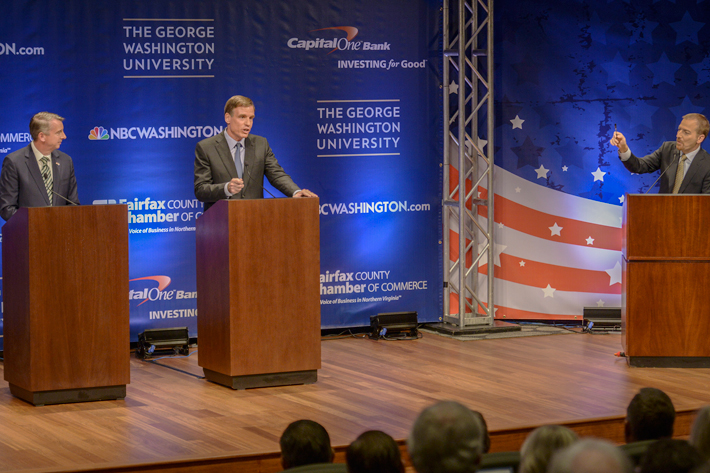By James Irwin
If Kelly Ayotte (R-N.H) needs help with voter strategy in her 2016 bid to remain a U.S. senator, she may want to ask a student in the George Washington University Graduate School of Political Management for help.
Students in Lara Brown’s National Campaign Dynamics class have been studying Sen. Ayotte—and other vulnerable incumbents in 2016—as part of a data-interpretation exercise to create campaign strategy memos that analyze election races, come up with the number of votes a candidate would need to win and develop a media strategy targeting specific voters.
“Our students can’t be good political consultants unless they get into the data and have an understanding of how the technology works to help construct a strategy,” said Dr. Brown, political management program director and associate professor at GSPM. “It’s important to wrestle with it in practice.”
Her class is one of several in the school using data analysis as part of the curriculum. Several are interpreting voter information provided by Aristotle, a campaign strategy company, to conduct deep-dive data analysis to create strategy.
Sen. Ayotte will find herself in a battleground state in 2016, Dr. Brown said, and campaigning alongside a host of presidential activity (New Hampshire has the first presidential primary).
“The Aristotle data allows you to run queries, so you can take a look at many demographic fields,” Dr. Brown said. “How many women are in New Hampshire? How many of them identify as Democrat, Republican, Independent? How many voted in 2010 and 2012? Then there are the lifestyle categories that can give you some clues as to ideological disposition. For example, you might not think gun rights matter to a woman in the Northeast, but if you find out she has a hunting license then you might suggest that she might have a disposition toward more liberties regarding guns and therefore more open to conservative messages.”
Those pieces of lifestyle information—magazine subscriptions, hobbies, memberships in organizations—could be critical, she said, for political strategists running campaigns at the national level, especially when it comes to deciding where to funnel resources late in campaign season.
“The digital and data effort allows us to understand what types of people we need to turn out to the polls,” Reince Priebus, chairman of the Republican National Committee, said in a recent visit to GW. “Data analytics can tell me, on a scale of zero to 100, what your propensity is to support our candidates. So if I’m in Iowa, and I get 100,000 absentee ballots, I want to make sure I know what 100,000 people I want to send the absentee ballot to.”
Polling is another data-rich area for GSPM. In Jamie Chandler’s Political Data and Analysis class, students receive an overview on the information behind political polls, allowing them to test their methodology, analyze their findings and critique how they are reported.
“The best part of the class is the practical element: we are regularly given polls to analyze and are then asked to determine how its findings could be applied usefully to a political management scenario,” said Zoe Clarke, a first-year GSPM student enrolled in the course. “Given the increasing importance of data to political management, getting the opportunity to learn not only how to read data but also how we can use it to inform political strategy means that we are better prepared to use it effectively.”
 Demographic and lifestyle data can help shape local grassroots projects like creating bike lanes or dog parks, said Ed Grefe, GSPM adjunct professor. "You can use all of this information today to discover people. And if you find there are people of a certain age, income, lifestyle—they read certain publications or listen to certain music—that tend to be open to a discussion about an issue, you can expand on it." (Daniel Oines/Flickr Creative Commons)
Demographic and lifestyle data can help shape local grassroots projects like creating bike lanes or dog parks, said Ed Grefe, GSPM adjunct professor. "You can use all of this information today to discover people. And if you find there are people of a certain age, income, lifestyle—they read certain publications or listen to certain music—that tend to be open to a discussion about an issue, you can expand on it." (Daniel Oines/Flickr Creative Commons)
In community advocacy, data plays a role in identifying the right people to engage in a local project or influence others to join a cause.
“In one sense [data] has not changed the game at all, and in another sense it has changed it completely,” said Ed Grefe, a GSPM adjunct professor who has more than 40 years of experience in communications and politics as a journalist, political strategist and grassroots organizer. “Ultimately, it’s still about one person getting another person to do something. Where it has changed is the number of people that can be touched has grown exponentially.”
Mr. Grefe teaches Grassroots Engagement. Students in his classes have explored many advocacy topics in recent years, including creating dog parks in neighborhoods, street cleanup and Metro rail expansion. His class this year is attempting to create a strategy to repair race relations in Ferguson, Mo.
The class conducted surveys in a local community that had similarities to Ferguson. Surveys and focus groups can give a grassroots strategist a fairly authentic look at how people react given certain facts, Mr. Grefe said. Data mining, a process of discovering patterns in large sets of data, then lead to the discovery of a block of people who tend to be open to a discussion about a certain issue.
“In community advocacy, if you’re going to change the way a community views something, it’s built on an intellectual basis,” Mr. Grefe said. “Change comes about by taking people from where they are and then finding out under which circumstances they are willing to change. I think using these tools allow students to truly become change-agents.”




